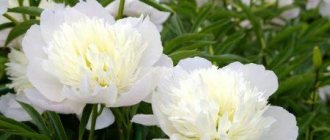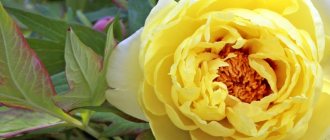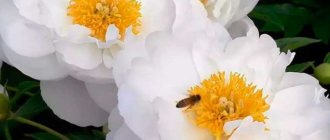The best early varieties and hybrids of peonies
This section of the article contains very early and early varieties of peonies with photos and names - they all bloom at the very beginning of June.
"Aritina Nozen Glory." The bush is beautiful, reaches a height of 70 cm, leafy, semi-spreading. The buds are lilac-pink in color, 20 cm in diameter. A flower with one row of wide outer petals. The stamens are bright yellow, collected in a pompom. Stems are pubescent, straight, strong. The leaves are large, carved, light green in color.
"Pearl placer." The bush reaches a height of 80-85 cm, slightly spreading. Japanese type bud. The description of the color of this peony variety is reminiscent of the “Aritina nozen Glory” variety - the inflorescences also have a lilac-pink color, but their diameter is slightly smaller (up to 14 cm). The stamens are modified, with bright pink tips. The flower is densely double. Feature - the bush grows quickly. The stems are straight, the leaves are small, bright green.
"Anne Berry Cousins." The bush reaches a height of 90-95 cm, compact, slightly spreading. The buds are coral pink, with yellow stamens in the center. The diameter of the flower is approximately 16 cm. The petals are arranged in 5-6 rows. It has an unusual luminous color. The leaves are quite large. The stems are thick, strong, slightly deviated, light. The foliage is dense. The hybrid of this variety of peonies is simple, semi-double.
"Lastres." The bush reaches a height of 70 cm. Quite compact. Beautiful buds of bright red color, yellow stamens with red veins. The diameter of the flower of this variety of peonies is approximately 19 cm. The buds are arranged in 4-5 rows, the stems are thick, with large leaves, and light. The leaves are bright and shiny. The flower is semi-double and has a pleasant, unobtrusive aroma. Looks good in a bouquet.
"Velma Atkinson." The height of the bush is 80 cm. The buds are bright carmine pink, with a diameter of 18 cm.
Look at the photo of peonies of this variety: the stamens are bright yellow and pink. Cream-colored petalodies. Japanese type variety. The leaves are green and shiny. Stems and leaf petioles are reddish in color. The petals are wavy. The variety is distinguished by abundant, long-lasting flowering due to the fact that it has many side buds on the peduncle. Fragrant. Great for the garden.
"Snow Mountain" The height of the bush is up to 75 cm. The buds are cream-colored, 17 cm in diameter, the variety has strong stems. The leaves are dark green and shiny. Peduncles are strong, but bend. Peony flowers of this variety have rounded petals. The aroma is average. Resistant to adverse weather conditions, as well as diseases and pests; winter-hardy and drought-resistant. The variety is a cut variety and can be used in landscaping only with a support. This is a universal one, one of the best varieties of peonies; it can be grown throughout Russia, except for the Far North.
"A la Mode." A beautiful variety. The bush reaches a height of 80 cm, semi-spreading. The buds are bright white, sparkling. The form is simple. The flower is large, reaching 21 cm in diameter. The stamens are bright yellow, which form a dense pompom in the center of the flower. The variety has good flowering. The stem is erect, on which up to 8 buds can be located. The flower has a pleasant smell. Can be grown everywhere. Sufficiently resistant to adverse weather conditions.
"America". A beautiful compact bush of this garden variety of peonies reaches 75 cm in height. The flower is dark red, up to 21 cm in diameter. Simple in shape, non-double. The petals are wide, with smooth edges, corrugated. The buds are shaped like tulips. The stamens are short, bright yellow, collected in the form of a pompom. Each stem contains up to 4 buds. The leaves are very decorative, green in color. The flower opens with wide, even petals. Has a slight odor. The variety is universal.
Here you can look at the photo to see what peonies are of very early and early varieties:
Brief description of popular varieties
In order for the peony bush to take root well on the site and delight the owners and their guests with its appearance for a long time, you need to select a suitable variety for planting.
Sarah Bernhardt
Peony Sarah Bernhardt was developed more than 100 years ago. The stems of this herbaceous terry peony reach a length of 70-80 cm. They bear 2-4 large pink flowers. The bush of the plant is quite strong, so there is no need to support the branches with additional supports. Flowering, which can be observed for 3 weeks, begins in June.
Grows well in slightly acidic soils. When growing a plant on fertile soils in the first few years, you can do without fertilizing. After 3-5 years, it is advisable to fertilize the soil with compost and apply mineral fertilizers before flowering begins. The cake is frost-resistant - tolerates severe frosts well. A common method of propagation is dividing the bush.
Coral
Peony Coral has varieties, each of which differs in color and slightly modified bud shape. So, the Sunset peony can be recognized by its peach color, Fairy - red-violet, Charm - lilac, Beach - coral, Pink - pink. The buds of each of these varieties have more than hundreds of petals, with the exception of Fairies - the number of petals of this variety is about 30.
Other features of the variety:
- The flowers have the same shape: large bright yellow stamens are located in the center of the double petals.
- The length of the stems can reach 1 m. The flowering part reaches a diameter of 16-17 cm. Charm has a larger form - 20-21 cm.
- Each variety of this variety has a distinct aroma.
- Flowering can be expected in late spring; it lasts for 7-21 days. Sunset blooms longer and maintains a fresh appearance until the end of the season.
- The roots are branched and powerful. When planting peonies, the distance between them should not be less than 85 cm.
- Plant care is standard.
- Frost down to 30 degrees is not scary for him, even in the absence of shelter.
- Reproduction is carried out by seeds or dividing the bush.
Red
Peony Red with a double bud of dark red color is often used by gardeners in landscape design. The diameter of the flower is dark red - 14-16 cm. The stems of the bush are 70-90 cm high, strong, the foliage is split. Red peony feels most comfortable in sunny areas, but longer flowering is observed in specimens growing in partial shade.
This variety is resistant to pests and diseases, and is also frost-resistant. It is advisable to plant it in fertilized soil. In this case, the plant will not require additional nutrients for several more years.
Red peonies are usually propagated by dividing rhizomes in August-September. After the onset of frost, in late autumn, the stems of the plant are cut so that 1-2 cm of stumps remain above the buds. For the winter, it is better to cover them with immature compost or peat. In spring, the insulating layer should be removed immediately after the snow thaws, since the buds begin to grow quickly.
Bartzella
Bartzell Peony - This medium-blooming flower is an American hybrid. The height of its spreading bushes is 80-90 cm. The leaves, painted dark green, gradually become bronze. The diameter of a double flower is 20-25 cm.
It is bright yellow, lush, and you can see red streaks at the bases of the petals. Since the flowers do not bloom all at once, flowering lasts for a month. The plant is winter-hardy, so only fresh plantings are covered for the winter.
Charm
Peony Charm is a semi-double perennial plant. Its 1 m high bush has strong long shoots with a red tint, dark green narrow foliage, often with a purple tint. Flowering begins in early summer, and the buds gradually change color - from dark salmon to rich peach-coral.
The diameter of the cup-shaped flower is 17-20 cm. The bright yellow stamens are clearly visible in the center. Gradually the petals fade in the sun and become yellow. The variety is drought and frost resistant, rarely attacked by pests and quite resistant to diseases.
Henry Boxtos
Peony Henry Boxtos is a hybrid of a milky-flowering peony and a medicinal peony. Brought out in the middle of the last century. This variety with double petals has a distinctive feature - there is another bud inside the flower, so it is large and heavy. The height of the bush is about 1 m. Sometimes the stems have to be supported, especially when several flowers form on them.
The flowers are burgundy in color, sometimes red. Flowering can be observed for three weeks. Henry Boxtos prefers slightly alkaline or neutral soils. It is better to plant it in a sunny area or in partial shade. Propagated vegetatively or using cuttings. Like many varieties of peonies, it is frost-resistant.
Peony Kansas
Peony lactiflora Kansas is very popular in China. It has a spectacular appearance. Resistant to cold, waterlogging, drought. This perennial plant is characterized by a long flowering period - the beauty of terry bright red or white buds up to 29 cm in size can be observed in May-June.
Stems with wide dark green leaves can reach a height of up to 1 m. With good care, Kansas peony can be grown in the same area for 10 years.
Pink
Peony Pink begins to bloom in early May and has a strong root system. The bushes of the variety are spreading, up to 1 m high, with many stems. If the plant is more than 30 years old, then their number exceeds 30. Large flowers (diameter - 20-22 cm) are dark pink in color with densely spaced petals.
Flowering is abundant and continues until early July. Grows best in sunny areas in warm climates. Before the onset of cold weather, the stems must be cut off and the plant covered with leaves or peat.
Solange
Peony Solange was bred by French breeders at the beginning of the last century. The bush is relatively low, 70-80 cm high. White-pink or white flowers are heavy and large. 3-5 flowers are formed on each stem. The variety is characterized by prolonged opening of buds and long-term preservation of flowers.
Flowering, starting in July, can continue until the end of summer. Agricultural technology is standard, but it is advisable to fertilize from time to time, providing the plant with nutrients: before the start of the season, you can use compost for this, and during the period of bud blooming - complex mineral fertilizer. For the winter, the bushes are covered with peat.
America
The America peony variety was bred by American breeders at the end of the last century. This ornamental herbaceous plant is distinguished by strong stems of light green color. Bush height – 70-75 cm.
Flowering begins in late May - early June. Reproduction is vegetative, since the plant does not have seeds. The bush grows strongly, 2-4 buds are formed on the stems. Flowers with a yellow core and two-row arrangement of red or white petals have a faint pink aroma.
Festiva
Peony Festava is a herbaceous plant up to 1 m high. The double inflorescences are snow-white, but there are red stripes in the center and along the edges of the petals. The flowers are large, they form on the shoots in large numbers. Flowering is observed in June for 1-2 weeks. The variety is grown on any soil.
If the soil is well fertilized before planting, then no fertilizing will be required in the coming years. In Maxim's care, the Festiva peony is unpretentious and at the same time drought- and frost-resistant. Reproduction is carried out by dividing the rhizomes. This work is usually carried out in late summer or early autumn.
Sorbet
The flowers of the Sorbet peony variety are semi-double or double with a diameter of 20-25 cm and are distinguished by a variety of colors - they can be yellow-white with pink splashes, pink, hot pink. The flower itself is three-layered with different shades that even out at the end of flowering. The bush is tall, can reach a height of 90 cm.
During flowering, which occurs in July, a large number of buds are formed. The variety is unpretentious in care, grows well in sunny areas and in partial shade. On acidic soils, it is advisable to liming the plant before planting. The plant should be watered abundantly, but it is important to take care of drainage. Sorbet is a frost-resistant variety that tolerates frosts down to -35°C.
Karl Rosenfeld
Bushes of the Karl Rosenfeld variety reach a height of 95-100 cm. The diameter of the flowers, which are crimson or violet-red in color and emit a sweetish aroma, averages 12-18 cm. Flowering, which begins in August, is long and abundant. Terry petals have a wavy shape.
The plant feels most comfortable in sunny areas. Early spring mineral fertilizing and the application of organic fertilizers during budding are mandatory. Watering is necessary in moderation, and drainage should be ensured.
The plant is often subject to attacks by aphids and mites, as well as fungal infections carried by ants, which usually appear with aphids. Therefore, in order to prevent all these troubles, it is advisable to treat plants insecticidal and fungicidal with special preparations before flowering.
Shirley Temple
The herbaceous variety Shirley Temple peony has a slender bush, the height of which usually reaches 75-80 cm. The diameter of large white-pink or white flowers is 20-25 cm. The leaves are dark green, but in the fall they usually turn red. Flowering occurs in July and can be observed for 2-2.5 weeks. The variety is unpretentious in care. You only need to water the plant from time to time and loosen the soil around the bushes.
In the fall, you need to apply organic fertilizer, and then cover the pruned bush for the winter. They can grow on any soil, but it is advisable to periodically fertilize depleted soil with mineral fertilizers. The variety is resistant to pests and diseases and tolerates frosts down to -30°C.
Shirley Temple is propagated at the end of summer by dividing the bushes. It is important to quickly release transplanted specimens from winter shelter in the spring, since they need time to enter growth. Flowering usually occurs in the first year after planting.
Duchess de Nemours
Peony Duchess de Nemours is a herbaceous peony. On a medium-sized spreading shrub, which is distinguished by powerful roots, shoots grow in all directions, which gives it lushness and volume. Beautiful dissected openwork foliage of dark green color turns crimson in the fall, so even with the end of flowering the plant looks unusual and attractive.
Milky white buds, when opening, can reach 15-20 cm in diameter. Outwardly, they are similar to light air clouds. The bases of the double petals have a faint green tint. In the center they are colored soft yellow and form a crown. But the peripheral petals are completely white. Some people, when they see the inflorescences of this variety, create the illusion of a glow from within.
Duchess de Nemours is a medium-late flowering variety. It begins in mid-July and lasts up to three weeks. The main advantages of this ornamental shrub are frost resistance (it tolerates frosts of 40 degrees), immunity to fungal diseases, and the absence of a negative reaction to wind and precipitation.
Primavera
Peony Primavera was bred in the last century by French breeders. The maximum height of the bush is 90 cm. Large flowers with a diameter of 16-18 cm have an interesting shape and color - the outside petals are wide, white-pink, and inside they are narrow, white-yellow.
Primavera blooms in July for about 2-2.5 weeks. Since the stems of the plant are thin, it is difficult for them to support massive buds, of which there can be 3-4 on each of them. Therefore, you should take care of additional support.
Red Grace
Peony Red Grace is an American hybrid, bred in 1980. The inflorescences are dense, dark red in color. The diameter of the flower is 18 cm. The core resembles a large pom-pom, and after full opening the flower resembles a corrugated ball.
The petals on the outside are round in shape. There are no side buds. The bush is tall, often reaching 120 cm. The dense stems have highly dissected openwork foliage. The shrub is spreading and symmetrical.
Armani
The stems of the luxurious Armani variety can reach a height of 1 m. Large maroon flowers with double thick petals become darker over time. The number of petals that are evenly distributed throughout the flower is more than a hundred. The decorative properties of the plant are not lost after flowering - at the end of summer the foliage becomes dark green, and at the beginning of autumn - dark red.
The plant must be planted in soil rich in minerals. The most acceptable option is to apply fertilizers to the planting hole. Thanks to this, you don’t have to apply fertilizer to the bush for the first few years. Young plants must be covered with compost or peat for the winter.
Joker
Peony Joker was bred by American breeders in 2004. A characteristic feature of this variety is that it is a kind of chameleon that changes color during flowering. At the beginning it is pale pink with a more intense color of the edges of the double petals, and at the end the color is completely different - pink-red.
The stem is short compared to other varieties (about 75 cm), but the flowers are very large, up to 30 cm in diameter. The leaves on strong stems, where 3-5 buds are formed, are brown-green in color. The buds do not open all at once, so flowering, which begins at the end of July, can be observed for about three weeks.
The Joker variety prefers slightly alkaline or neutral soils in sunny areas. Flowering is poor in partial shade and shade.
Julia Rose
The height of the Julia Rose peony bushes is 85-90 cm. On strong stems there are a large number of bright green leaves in the form of thin feathers. Flowering begins in the second half of May. Semi-double flowers, the diameter of which reaches 17-20 cm, are pink in color at the beginning of flowering, then they become peachy-pink.
There are bright yellow stamens in the center of the flower. The flowers have a delicate and very pleasant aroma. This variety is often used by flower growers when designing landscaping areas.
August Dessert
Lush double and semi-double buds of Auguste Dessert peonies really look like a cake with airy cream. The deep pink petals are edged with a silvery “thread”. This is what gives the flowers an exquisite and original look. Peonies of this variety look good in a flower bed and last a long time when cut.
| Purpose | Class | Stem height | Flowering time |
| Terry and semi-double | 60-90 cm | Mid-late |
Regular feeding of flower crops
At the very beginning of the growing season, the plants are fertilized with nitrogen. When small buds are just being laid and until the end of the season, phosphorus and potassium should be added to the soil. During active flowering, the shrub needs three components - nitrogen, potassium and phosphorus. At the same time, fertilizer rates should be moderate. After all, in an effort to help a plant, you can cause a lot of harm to it. For example, if you overdo it with nitrogen, you can provoke the development of rot. Plants should be fertilized after preliminary watering of the soil, on moist soil. This eliminates the possibility of burning the root system of the bush. Read the article: Remontant strawberries: a review of small-fruited and large-fruited varieties.
Agricultural technology for growing ITO peonies
ITO peonies should be planted in elevated and well-lit areas with low groundwater levels. ITO peonies will feel best on loamy, well-fertilized soils with a high humus content. The acidity of the soil should be slightly alkaline or neutral. The best time for planting ITO peonies is the end of August - beginning of September.
Peony root planted in a pot.
The optimal size of the planting hole is 50-60 cm in depth and 60-80 cm in diameter. “Divisions” of ITO peonies are planted in such a way that they are located strictly in the center of the planting hole and with a slight slope, and the renewal buds are located at a depth of 3-5 cm from the soil surface level. Planting holes are filled with pre-prepared nutrient soil, consisting of a mixture of humus and garden soil with the addition of a small amount of phosphorus fertilizers. To deoxidize, a small amount of ash or dolomite flour should be added to the soil. If you purchase planting material for ITO peonies with a closed root system, you should carefully, without disturbing the earthen ball, transfer the plant from the container into the planting hole, and then, observing the required planting depth, fill the planting hole with nutrient soil. After planting, the soil surface should be mulched to maintain its moisture and breathability.
Popular articles Creating a closed glass gazebo with a barbecue with your own hands
Caring for ITO peonies is generally the same as caring for ordinary herbaceous peonies. In summer, plants require regular watering and fertilizing.
It is especially important to provide plants with sufficient moisture in late spring - early summer, when active stem growth and bud formation occur, as well as at the end of summer, when plants are actively forming renewal buds. It is best to water ITO peonies in the evening.
In hot weather, it is advisable to moisten the soil surface daily. ITO peonies are watered exclusively “at the root”. It is highly not recommended to use the sprinkling method, since in this case the plants are very easily infected with fungal diseases. After each watering, the soil under the peony bushes should be loosened. The more oxygen the roots receive, the more beautiful and magnificent the flowering will be.
If proper agricultural practices are followed, ITO peonies do not require any fertilizing in the first two years after planting. Plants should be fertilized starting from the third year of their cultivation. In spring and early summer (during active growth and budding), plants are fed with nitrogen fertilizers, and at the end of summer (during the formation of renewal buds) - with a phosphorus-potassium complex.
The buds that appear in the first two years should be removed immediately, since the flowering of young plants can significantly weaken their development. In mature, well-formed plants, the first pruning is done in mid-June. At this time, the “old” dried flowers are removed, which promotes the formation of new renewal buds. The more of them are formed, the more magnificent and beautiful the flowering of ITO peonies will be next year.
When performing pruning, it is also important to carefully remove all leaves and petals that have fallen to the ground. This is done to reduce the risk of developing fungal diseases.
The second time ITO peonies are pruned in the fall - in the first half of October. This time, almost the entire above-ground part of the plants is removed, after which it is burned to prevent contamination of the plantings with fungal infections. When removing the aboveground part of ITO peonies in autumn, it should be remembered that the main renewal buds, which ensure further development and flowering of plants, are formed on the roots deep in the soil.
ITO peonies are very winter-hardy plants, so they do not require mandatory shelter for the winter. In particularly cold winters, you can sprinkle the planting holes with peonies with a layer of well-rotted manure
In the spring it will need to be carefully removed, trying not to damage the tender young shoots of plants
ITO peonies begin to bloom in the second or third year after planting. Their first flowers are usually not very beautiful - they have an irregular shape and curved petals, but later everything returns to normal, and the plants begin to delight their owners with luxurious blooms. According to most gardeners, ITO peonies gain maximum beauty in the fourth or fifth year of their development.
Peonies: agricultural technology for growing, propagation, planting and care (read more)
Tree varieties of pink peonies
If herbaceous bushes for some reason do not suit the gardener, they can easily be replaced with pink tree peony - a perennial, woody shrub.
Unlike its herbaceous relatives, its shoots do not die off in the winter, but become lignified, thus forming a kind of shrubby, flowering tree every year. As a rule, this variety is not very capricious in care. But growing it in your front garden can be a real challenge: the bush grows very slowly before flowering; you can only wait until the first buds from seedlings obtained from root cuttings appear in the fourth year after planting. It is generally difficult to get seedlings from large, glossy, black seeds, since only 1/3 of them will sprout. And for this you will have to spend a lot of time stratifying them. But time does not stand still, and lovers of tree peonies began to graft them onto herbaceous varieties (for example, Pink Jade, Black Pearl or Pink Azure). Such a seedling will become a full-fledged “peony tree”, but you won’t have to wait so long for flowering - it will bloom its beautiful flowers within the first year after planting. The following varieties are popular: Pink Powder, Marshmallow, Pink Lu, Pink Lotus, Pink Zhao, Qipao, Red Giant, Silver and Goldfish.
Variety Pink River
The Pink River tree peony is a wonderful option for any garden. It blooms extremely beautifully - large semi-double flowers, 17x5 cm in size, reminiscent of chrysanthemums in shape. The color of the petals changes from light pink at the top to a darker, purple color at the base. Numerous stamens with bright yellow pollen add to the beauty. The bush is quite large: height – 1.1-1.5 m, width – up to 1.5 in diameter. It exudes a very delicate aroma, in harmony with an equally sophisticated appearance. It blooms early, is undemanding in care, resistant to diseases and pests. The only thing you need to remember is that, like all woody peonies, it does not like transplants, drafts and shade.
Variety Pink Cloud
The Pink Cloud peony looks unusually delicate on the site and also has an incredibly delicate, barely perceptible aroma. The flowers are double, large - 16x11 cm, many thin, delicate petals of a light pink hue create the visual impression of a light cloud that appeared at dawn and fell under the radiant rays of the Aurora.
The stems are dense, with 3-5 buds on them. Bushes of medium height - 80-90 cm, leaves are carved, dark green. The peony tree blooms in the mid-late period, very profusely.
Varieties of peonies with medium flowering period
Among the varieties characterized by an average flowering period, o. This universal variety, resistant to various diseases, is ideal for growing in Russia, with the exception of cold regions of the country. The maximum height of the bush is 0.8 m. The buds with wide petals are similar to rose buds. The shades are mixed: inside – light pink with yellowness, outside – creamy pink. These peonies have a pleasant jasmine scent.
A variety called “In Memory of Gagarin” is noted, which has an unobtrusive aroma. Its pink buds (18 cm in diameter) have wide light petals of a pinkish hue, a yellow base.
The variety called “Top Brass” is resistant to the negative effects of the environment, pests and diseases, the bush of which reaches 0.9 m. The flower of the bush has an original shape with wide lower petals of a cream shade in the lower tier and yellow in the middle.
Features of caring for peonies
In many ways, caring for a tree peony coincides with caring for its brothers - herbaceous perennials and is not particularly difficult. It is necessary to water with the same regularity and intensity as conventional varieties: the need to loosen the soil, remove weeds, feed and water.
Twice a month it is advisable to water the plants thoroughly, using about 6 liters of water/1 bush. In August, watering should be completed, the soil around the bushes should be carefully loosened (no deeper than 5 cm), the weeds should be pulled through and sprinkled with mulch.
Tree peonies: features
Tree peony or subshrub is a hybrid plant of the peony family. Although some scientists do not distinguish it as a separate species, but classify it as a group of forms and varieties of hybrid origin. Most of these plants grow in China. It should be noted here that these varieties are mostly the result of the hard work of Chinese breeding scientists.
This variety was brought to Europe at the end of the 18th century. These plants are deciduous shrubs, reaching a height of two meters. The stems are erect and thick, colored light brown. They do not die off every autumn; on the contrary, they grow every year and over time turn the plant into a huge bush shaped like a ball.
The leaves of this variety are double-pinnate, ornamental, and openwork. The plants have very large flowers. They often exceed 20 cm in diameter, which are located at the ends of the shoots and can have different colors - yellow, white, crimson, pink and even two-tone.
Another peculiarity of tree peonies is that the older the plant gets, the more flowers bloom on it. These peonies bloom half a month earlier than herbaceous peonies, and this process lasts about three weeks. In addition, tree peonies are cold-resistant. Growing them in temperate climates is not difficult. But if in your region the temperature in winter drops too low, then it is recommended to opt for special frost-resistant varieties (Peter the Great, Hoffman, Moscow University).
Features of the classification of pions
It is difficult for novice gardeners to choose a specific variety for their plot. To make a choice, it is worth understanding the varietal differences of the flower. Depending on how the bud is arranged, peonies are distinguished:
- Terry. Their petals form a dense rosette with fringed edges. Stamens and pistils are practically invisible.
- Non-double with petals, which are located in each bud only in one row. This type is characterized by decorative options and hybrid forms.
- Semi-double, the petals of which are located not on one, but on several rows.
Depending on their origin, peonies can be tree-like or herbaceous. The former have about 500 varieties. They can reach a height of up to 2 m. In the second group there are about 4,500 varieties. All of them are easy to grow and can grow in one area for many years without replanting.
Varieties of milky peony (with photo)
Varieties obtained from the milky peony (P. lactiflora) are the largest group, the most typical and familiar flowers to us. Usually large, densely double. But in this group there are also peonies with all other flower forms, most often with the Japanese (anemone-like) form. Flowering time is late compared to other groups. Varieties from the milky peony are distinguished by their viability and longevity. Subsequently, the reduction is Lact. used when describing varieties of this group.
Hybrid varieties are obtained from interspecific hybridization of herbaceous peonies within the Peony section. There are a lot of such combinations.
Speaking about what types of peonies there are, we can distinguish three main groups:
Hybrids between P. lactiflora and P. officinalis (combination P. lactiflora x P. officinalis or the reverse) or a related P. foreign (P. Peregrina).
Popular articles Description and cultivation of forest forget-me-nots
The most common group of hybrids. Hybrids of this type have attractive, clear, vibrant pink and red colors. Most of them have a simple and semi-double flower form, but the available double varieties are popular and valued. They begin to bloom and complete flowering approximately 1-2 weeks earlier than varieties of P. lactiflora. Usually they can grow successfully in one place for up to 10-15 years.
Hybrids from P. lactiflora and P. thin-leaved (combination P. Lactiflora x P. tenuifolia) have a simple flower shape of a deep red color, small bush size, openwork, unusual finely dissected leaves. They begin to bloom in our strip from the end of May - the very first days of June.
Hybrids from P. lactiflora and peonies of Caucasian species are attracted by the earliest dates of flowering, from the end of May. The flowers are simple and double in shape, with colors ranging from white and creamy yellow to pink.
For example, varieties of milky-flowered peonies Sania Boy and Ballerina are double with a yellow color.
When describing hybrid pions, the following designations are used:
- G1 - hybrid of p. officinalis;
- G2 - hybrid of fine-leaved plant;
- GZ is a hybrid of items of the Caucasian flora (usually from items of Wittmann or items of Mlokosevich);
- G - an interspecific hybrid, without detailing the parental pair, or when it has not been established, from another combination or from a combination with several species of peonies without certain phenotypic characteristics.
Look how beautiful the milky-flowering varieties of peonies are in these photos:
Species peonies are natural plants. Picturesque and varied.
Among the most popular in Russia:
Early flowering species of peonies of the Caucasian flora - Caucasian peony (syn. p. kavakhsky)
Pion Mlokosevich
Crimean peony
Peony evading - Maryin root
Thin-leaved peony (P. tenuifolia) with unusual finely dissected (fern-like) leaves.
This group appeared in the 70s. XX century The varieties belonging to this group have the phenotypic characteristics of both. First of all, varieties with a stable yellow color, which is absent in herbaceous peonies, are interesting. They are still not widespread and have not been sufficiently studied. Although they are quite successfully cultivated in central Russia. They equally have the characteristics of both herbaceous and tree-like peonies.
Two-color peonies
Exotic colors in modern varieties of peonies are not uncommon. What adds spice is that color combinations can be played out in different ways. These can be stains, strokes, stripes, spots, differently colored petals.
Peaches and Cream
There is a variety with a similar name - Peach and Cream. But the Peaches and Cream variety has different flowers - they look like a dessert of fruit and ice cream.
The coloring magically combines cream, pink and peach tones. Flower – 14 cm, bush – 90 cm.
Kirinmaru
A ball of white petals with thin crimson stripes, like streams. Flower – 15 cm. Bush – 80 cm.
Raggedy Ann
Still a rare variety. Large flower 16 cm with huge numerous pistils. The petals are soft pinkish-white with blueberry-purple spots at the base. The strongly jagged edge of the petals adds piquancy. Bush – 70 cm.
Raspberry Sunday
Balls of amazing colors, pink at the bottom, vanilla in the middle, pink-raspberry on top. The colors are very delicate, filling, and the boundaries between the stripes are clearly visible. Flowers – 18 cm, bush – 70 cm.
Julia Rose
The flower is semi-double, large, silky, gradually changing color from cherry-red to apricot and then yellow. The coloring is watercolor, sometimes the flower looks like it has a border, but mostly the stains are irregular. Flower – 18 cm. Bush – 90 cm.
American varieties
Terry peonies, beloved by most people, continued to be created later, already in our time, within the framework of the usual ideas about what this flower should be. Many new varieties and hybrids that have replenished the world's collection have become the subject of admiration. Most modern varieties come from the USA, where the center of selection has moved from France.
Huge peony flowers of the American selection 'Jessie Gist'. Photo by the author
American breeders managed to achieve stunning results. They created hundreds of new - wonderful peonies. There is no way to list everything, I will only name varieties that evoke admiration for the impeccable shape and size of the flower, abundant flowering and texture of the leaves. The champion among pinks is rightfully considered the variety 'Dinner Plate', whose pink-pearl flowers are indeed the size of dinner plate, as the name suggests. Their diameter is 20-25 cm, this is an absolute record!
'Dinner Plate' is a flower the size of a dinner plate. Photo by the author The variety 'J.S.' stands out from the white ones. Nicholls' ('JC Nicholls'), whose densely double huge flowers last on the bush for a very long time. They bloom pale pink, with a yellow highlight inside, then turn white and become ivory.
'J.S. Nicholls' is an outstanding peony among white varieties. Photo by the author Among the reds there is a hybrid 'Henry Bockstoce' ('Henry Bockstos'), which cannot leave anyone indifferent, it is so good! The double flowers are of a deep red color without an admixture of blue, unlike other similar peonies. Huge flowers with a diameter of more than 20 cm, in the center there is a ball-bud of twisted petals, reminiscent of the forelock of a poodle-cut. The leaves are light green, which is rare among peonies. Peony 'Henry Bockstoce' is a repeated winner of flower exhibitions. Photo by the author The palette of pink peonies is extremely wide - from the most delicate shades of a girl’s blush to rich pink tones. This is 'Jessie Gist' with peach highlight in the center of huge double flowers; 'Princess Margaret' ('Princess Margaret')
Profusely blooming 'Princess Margaret' and its neighbor 'Henry Bockstoce'. Photo by 'Mrs. F.D. Roosevelt' ('Mrs. F.D. Roosevelt'). 'Gladys Taylor' ('Gladys Taylor')
Peony flower 'Mrs. FD Roosevelt'. Photo by the author Meanwhile, in recent years, peonies with simple, non-double anemone-shaped or so-called Japanese-shaped flowers, which (alas!) very often have no scent, have gradually come into fashion. Most of the newfangled varieties are also appearing in the United States. coral series
Pests and diseases
Peonies have high immunity, but from time to time they are still susceptible to diseases such as:
- Tobacco rattle virus or peony ringspot virus. Small rings or stripes of yellow or green appear between the veins on the leaves. It is recommended to remove affected plants and burn them. However, the severity of the disease depends on the variety. Some varieties are resistant to this virus.
- Gray rot manifests itself in the presence of gray mucus on the leaves of peonies, which gradually kills the plant. Young shoots are most often affected. If rot appears during the bud opening period, then large flowers that have already opened take on a brown tint. And the buds themselves turn black. Rot appears due to improper care and heavy rains. It is necessary to treat the plant with fungicides to get rid of the problem.
- Rust is characterized by the presence of brown spots on peony leaves. After a while they curl and dry out. To combat it, fungicides such as “Topaz” and “Vectra” are used 2 – 3 times in 10 days.
- Root rot occurs due to the influence of fungi. The root becomes covered with mucus and begins to rot. As a result, the stem darkens and the plant withers. You need to dig up the flower, cut off the damaged areas and clean them of mushrooms. The soil should be replaced and the affected one disinfected.
In addition, gardeners growing white peonies have to deal with the following pests:
- bronze beetles;
- root-knot nematodes;
- ants;
- aphid;
- spider mite
A solution of soapy water or industrial poisons are used against these insects.
General information about peony flowering
Peony is a perennial crop that can grow in the same place for a long time - for 20 years. The underground part forms a fleshy tuber, from the buds of which stems emerge. They reach 1 m. Over the years, the peony tuber thickens, and additional roots appear from it. All peonies can be divided into 2 large groups - herbaceous and tree-like.
The flowering of peonies depends on many factors
Age of first flowering
Many people are interested in what year after planting the peony blooms. It is worth considering that plants are not able to bloom in the first year of life. They require a longer period of time to fully develop. First of all, the plant spends energy on rooting and acclimatization.
Important! In the first year you should not expect even a large number of shoots. In the second year, the tuber thickens and the number of stems increases
Small buds may form at the ends of the branches. It is not recommended to let them bloom. It is better to immediately tear off the buds so that the culture does not waste energy on them. Otherwise, they may not be enough for the development of the plant.
In the third year, the time for peonies to bloom comes. However, it may not be too abundant.
Full flowering occurs only in the 3rd year
Peony lifespan
Tree crops have a good life expectancy. On average, they develop for 100-200 years. Varieties of herbaceous plants can grow for more than 80 years.
Note! Hybrid crops are considered less durable. The lifespan of such plants is a maximum of 10 years.
Features of flowering
Tree-like plants are more commonly grown in China. Their features include large inflorescences. Petals can have different shades - white, crimson, lilac. At the base of the flower there is a spot of rich pink color.
- Hybrids have yellow flowers, which are undemanding and resistant to dry weather.
- Japanese tree peonies are smaller in size. Moreover, they are characterized by semi-double petals that have an interesting shade.
- There are also dark red and burgundy buds, which turn purple at the ends.
- The combination of white and red shades looks interesting.
- Some varieties have a citrus aroma.
Popular articles Making a pond from a tire with your own hands
In the middle zone you can more often find herbaceous crops. They have many species and hybrid varieties. In this case, double and semi-double petals are found. Anemone-like cultures contain stamens in the center. They are surrounded by many petals.
Anemone-shaped peonies look very impressive
Care during flowering
During the flowering period of peonies, they require complete and high-quality care. It is recommended to start it at the stage of bud formation. In this case, the plant needs active watering.
Before the buds appear, peonies should be treated with copper oxychloride. It helps prevent the development of fungi. If you plan to cut flowers into buds, it is recommended to leave at least 2 petals on the branch.
Important! To achieve timely formation of flower buds, it is recommended to add phosphorus and potassium in the spring. Peonies also need abundant watering and loosening.
Peonies need watering during flowering.
General description of peonies
Peonies (lat. Paeónia) belong to the peony family (Paeoniaceae) and are perennial plants that have large rhizomes that penetrate deep into the soil. The height of the bush can reach 0.75-110 cm. Decorative foliage is green with a purple tint. Foliage color changes throughout the growing season.
The flowers are single, large - their diameter is 15-20 cm. The shape of the flower depends on the variety. It can be terry, pink or spherical. The fruits are complex, multi-leafed, each containing several black seeds.
The frost and drought resistance of the flower allows it to be grown in different climatic conditions. However, it feels more comfortable in well-lit places, and it can grow in the same place for 10-12 years.
Peonies begin to bloom at the end of May, and some varieties bloom later - in July and even in August. The duration of flowering, depending on the variety, lasts from 1 to 3 weeks. Reproduction is by seed and vegetative.
According to the structure of the flower
Plant varieties differ quite significantly. And one of the main differences that experts actively use to classify crops is the structure of the flower.
Non-double
It is not difficult to identify such a decorative variety. Their flowers consist of one or two rows of petals, and in the middle there is a pistil, surrounded by a cluster of stamens and large anthers.
A pleasant feature is that it is the non-double peonies that begin to bloom earlier than other peonies.
Semi-double
The main distinguishing feature of this category is the especially wide petals, as well as the corolla, consisting of three, five, and sometimes seven rows! The stamens protrude directly between the petals, in some varieties they are ring-shaped, while in others they are collected in the center.
Fact! Peony is the only genus in the peony family, which is quite rare.
In recent years, these flowers have begun to be grown in open ground in Russia.
Japanese
Japanese peonies stand out sharply against their background. Their outer petals are arranged in one or two rows, and in the center there are very narrow ones - in fact, these are modified stamens. An interesting feature is the fact that these petals do not stick out, but bend inward, thus forming a kind of “pillow.”
Anemoneaceae
According to many experts, the most luxurious peonies fall into this category. Their outer petals are large, and in the center there are petalodes - they look like modified stamens, but are quite short.
Some gardeners value anemone-shaped peonies for their unusual feature - the inside of the flower has the same tone as the outside - contrast is very rarely observed.
Terry: bomb-shaped, hemispherical, spherical
Terry peonies are usually further divided into three subgroups depending on the shape of the flower. Their petals are very wide, but these plants have no stamens or pistils at all! This means that pollen is either absent or sterile. Because of this, terry peonies do not produce seeds; they can only be propagated vegetatively.
Rosaceae
In general, this is a special case of terry peonies. As the name suggests, the flower is similar to a rose. Pink peonies have petals of the same size, collected quite compactly, only slightly smaller in the center than on the outside.
Crowned
Crowns are characterized by the presence of 3 tiers, the top of which forms, as the name suggests, a “crown”.
Note! Their large flowers reach up to 20 cm in diameter
Because of her thick pink crown, Barbara gets the most attention
Early flowers
Early varieties ripen in late May or early June. They can produce large buds for several weeks. In this case, no special care is required.
Here are a few of these varieties:
- A scattering of pearls, with a Japanese bud. One bush can have over ten flowers, and the bush itself is short (up to 85 cm in height).
- Edulis Superba, the height of the bush reaches 120 cm. It has rich pink buds that reach about 10 cm in diameter. The aroma is persistent.
- Germaine Bigot is a soft pink color. The buds do not exceed 14 cm, and the bush grows about 80 cm high.
- Marshall MacMahon is a variety with double buds, the size of which reaches 12 cm.
- Sarah Bernhardt grows up to 100 cm. The bush can contain up to 10 buds at a time.
Finding flowers that will delight gardeners in early summer is not difficult. You just need to understand what color you want to see. Moderate watering and timely planting will allow the peony to grow quickly. However, the first flowers appear, as a rule, after 2–4 years.
Tree peonies with white flowers
Scent of Lily (Zhong sheng bai)
| The Smell of Lily variety is a tall bush with a large number of snow-white flowers with shiny petals. In the center of the inflorescences there is a bright yellow crown of stamens. |
The peony grows quickly and bushes well. The variety got its name due to the similarity of the smell of its flowers with the aroma of lilies, which, unfortunately, cannot be conveyed through photos..
- The height of an adult bush is 1.5 m.
- Flowering begins in June.
- The flowers are semi-double, 16 cm in diameter, the aroma is bright and memorable.
- Frost resistance zone – 4 (Moscow and Moscow region).
Anastasia Sosnovets
The bush is semi-spreading, the stems are strong. The inflorescences are cup-shaped with a 2-row corolla, located above the bush. |
The color is dazzling white with a purple spot at the base of the petals. The stamen filaments are light, the stigmas are light yellow.
- The height of an adult bush is 1.2 m.
- Flowering begins on June 10.
- The flowers are simple, 16-20 cm in diameter, with a strong aroma. The number of buds on an adult plant is 30-50 pcs.
- Prefers drained soils without stagnant moisture.
- Frost resistance zone – all regions.
Maria
A large white flower with a pink center, two-row petals. The bush is semi-spreading, with strong shoots. There is one flower on the peduncle, it does not droop. |
- The height of an adult bush reaches 1 m.
- Flowering from May 23 to June 3.
- The flowers are semi-double, hemispherical in shape, 18-23 cm in diameter, with a pleasant aroma.
- Resistant to fungal diseases.
- Frost resistance zone – all regions.
Snow Tower
| An easily recognizable variety by its anemone-like flowers. The petals are pink-peach at the base and fade to white towards the edges. The inner petals are long and narrow, slightly serrated along the edges. There are few stamens. Flowers look up. |
- The height of an adult bush reaches 1.2-1.8 m.
- Flowering lasts 2 weeks in May-June.
- The flowers are double, crown-shaped, 20 cm in diameter, with a delicate aroma.
- A profusely flowering plant.
- Frost resistance zone – 4 (Moscow and Moscow region).
White Jade
| An ancient variety of tree peony, which is distinguished by its snow-white petals and golden corolla of numerous stamens. Flowers in the shape of a lotus look advantageous against the background of dark green carved foliage. |
- The height of an adult bush is 1.5-1.7 m.
- Flowering occurs in May-June for 12-14 days.
- The flowers are semi-double, 17 cm in diameter, with a delicate, sweetish aroma.
- The number of buds on an adult plant is 25-50 pcs.
- Frost resistance zone – 4 (Moscow and Moscow region).
Thanks to their rigid flower stalks, peonies look great in a bouquet.
Silk Veil (Gui Fu Ren)
One of the best double white tree peonies. Huge, dazzling white flowers bloom from green buds with a dark purple spot at the base of the leaves. The background for such splendor is the gray-green leaves on strong stems. |
- The height of an adult bush is 1.2-1.5 m.
- Flowering begins in mid-June.
- Double flowers, 20 cm in diameter, delicate aroma.
- The number of buds on an adult plant is 40-60 pcs.
- Frost resistance zone – all regions.
Japanese peonies
There are not very many Japanese peonies. The most interesting varieties of Japanese peonies with names and photos:
- Easy Lavender - pink-lavender bright petals and the same center.
- Rheingold - white outer petals, bright yellow center. The petals in the center are dense, quite thick.
- Golden Bracelet is an interesting variety not only in itself, but also because it belongs to the double crowned Japanese varieties; it is an intermediate variety in this group. The variety has several rows of large white petals, the staminodes are soft gold, and a high center in which white, but narrower petals are visible again. The flower looks like an exotic chrysanthemum.
- White Sands. It is sometimes classified as an anemone group. The flowers are white, with a yellow center, and lush.
- Neon is an original peony of bright lilac-pink color. The staminodes have the same color, but there is a nuance - each of them has a very bright contrasting golden-yellow edge, as if each petal was outlined with a pencil.
Japanese varieties tend to be very aromatic. The aroma can have fruity or oriental shades.











